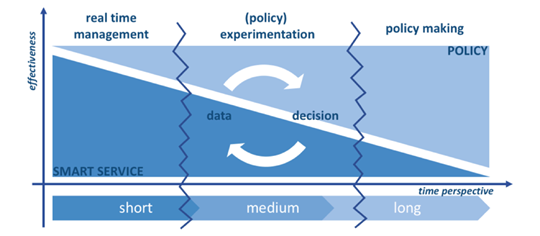Chapter 0.2: A new experimental approach to policy making
This chapter introduces students to the experimental dimension of policy making.
Decision making in cities occurs on different levels and over different time frames. For example, at a policy level, the decision on where to build a new train station may take years, whereas at an operational (real time management) level, the decision on where to divert traffic following an accident happens in a matter of minutes. Traditionally, the real time management level is a service-supported decision and aims to create a real-time temporary benefit, whereas the policy oriented one results in a permanent impact. This is why the latter usually involves a longer and more complex planning process.
Yet today, in our increasingly digital era, the availability of urban data from city sensors means the boundary between service and policy decisions are becoming blurred. The ability to gain fast insights from data means that policy making and service management both have the potential to benefit from the same data sources.
Three dimensions of decision making
Today, we can generally distinguish between three different decision levels: real-time management, policy making, and policy experimentation.

Figure 1: Three dimensions of decision making
Real-time management involves operational decision making to solve many daily problems. Such problems can be detected by service managers through the continuous analysis of real time data to recognise situations and apply solutions/decisions that have already been proven to work. For instance, traffic monitoring systems could be used to detect traffic jams and make real time decisions to redirect drivers.
Located on the opposite side of real-time management is the policy making domain, which is characterised by longer time horizons and more analytical decisions based on deep field research, written citizen consultation, as well as first-hand experience of policy makers. Policy making is mostly a long, recurring sequence of three main cycles:
- Policy design: Here, problems are highlighted and solutions are proposed to solve them
- Policy implementation: At this stage policies are put into practice
- Policy evaluation: The final step where the impacts are analysed and assessed
Recently, the PoliVisu project coined a third type of decision making that sits between real-time and long-term policy decisions called experimentation. In this area decision making benefits from the same kind of real-time data and speed of management decisions, but also from the detailed and collaborative nature of policy making. Here, the policy making cycles are reimagined as ones of continuous experimentation, where policy makers and service managers work together and support each other whilst benefiting from collaboration with other stakeholders.
The added value of policy experimentation
New methods of data collection and analysis enable policy teams to conduct experiments (e.g. scenario simulations) and to observe impacts of different interventions before agreeing on the best way forward. In this respect, data visualisations are not just a tool for making sense of complex simulations, they also provide a means to learn from the experimental reality and adjust next steps accordingly.
Instead of running lengthy consultations and managing multiple costly pilots to understand the impact of potential decisions, policy makers can experiment and simulate the impact of different decisions using online policy visualisations. By using these visualisations, policy makers can identify and explore problems, design solutions, and understand potential impacts of different interventions all without having to run real-life pilots which can be expensive and time-consuming.
Having a virtual environment for trial and error provides an opportunity to learn in an agile manner. With an experimental approach, policy makers can re-design and tweak new policy solutions and monitor and adapt already implemented measures to mitigate any undesired effects. In the experimental dimension, policy design and implementation are merged in a way that allows public administrations to face complex and evolving problems in a more efficient, systematic and dynamic way.
Reducing the gap between operational management and policy
As the gap between city policy making and service operations is reduced, traditional high-level strategic decisions are transformed into more adaptive, context driven solutions, in effect becoming smarter, better aligned policies and services. However, for experimentation to be successful the visualisations must be usable and understandable by policy makers and service managers who don’t often have the necessary data/analytical background. The next chapter therefore covers the importance of data literacy for policy makers, which is the ability to both understand and use data.
